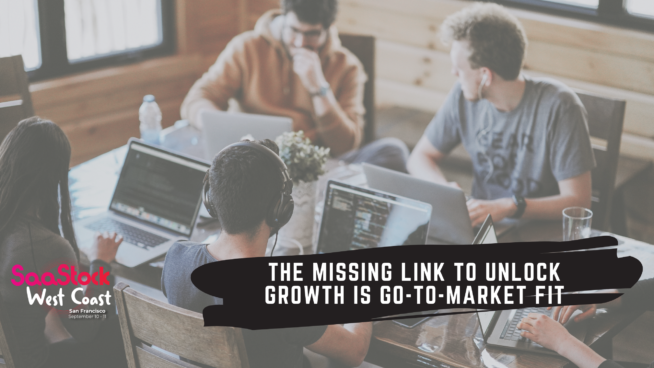This guest post about go-to-market fit is by Bob Tinker, Co-author of Survival to Thrival: Building the Enterprise Startup: Change or be Changed. Bob is also a Seed Investor, as well as a former Enterprise CEO. He will be speaking at SaaStock West Coast this September alongside his co-author and Storm Ventures MD, Tae Hea Nahm. You can still grab a ticket to see them as well as over 20 other excellent speakers in San Francisco.
As an early-stage investor, I have met with hundreds of CEOs and founders and worked closely with over eighty teams in which I invested. Some were successful, some were not. I have seen companies hit the wall and die within a year. Yet some successfully unlock growth and go on to pass $100m / year in revenue. Why the difference?
That’s the question that me and my co-author, Tae Hea Nahm from Storm Ventures, set about quantifying in our book series Survival to Thrival, and what we will share in our SaaStock talk this September.
Some of the macro patterns might be obvious – right market, right team, right product. But that isn’t always enough to explain why some startups make it happen and some don’t. There are other common patterns.
Pattern #1: Companies that get to Product-Market Fit (PMF) and win their first set of customers, but then never seem able to unlock growth
Many entrepreneurs think that finding PMF is enough. Indeed it generates early excitement, but why do many fail to then accelerate from $1M in ARR to $20M ARR and then to $50M in ARR? In the first part of our talk, my co-author (Tae Hea Nahm) and I will talk about the missing link between PMF and unlocking growth. We call it ‘Go-to-Market Fit’ (GTM fit). We noticed that companies which had unlocked growth had:
1. Found urgency
2. Nailed their go-to-market fit model
3. Built a repeatable go-to-market playbook to find and win customers over and over again.
They were able to transcend from founder-led selling to predictable, repeatable, and scalable growth. This means a company (and its investors) can now run a model: invest more capital in sales, marketing, product, and generate predictable growth! Sounds perfect, right? But maybe not.
Pattern #2: Once growth unlocks, all hell breaks loose for the team.
It’s really hard on them.
As a startup begins to accelerate, the company changes. Therefore everyone’s job changes right underneath them. It applies to everyone from the CEO to the middle managers/leaders, even to the board. What used to work suddenly stops working. It’s maddening and frustrating for them, yet it’s totally normal.
This is what we will focus on in the second part of our talk, and the focus of the second book in our series – Change or Be Changed. There is little institutional knowledge passed down to help startup leaders adapt to change. We collected a load of anecdotes on lessons learned, from entrepreneurs who succeeded and failed to navigate the personal changes that come with growth.
So, how does the team adapt?
The key is counter-intuitive. We call it Unlearning. The very behaviors and skills that were critical to a leader’s success at one stage now become liabilities and hold the leader back. It’s extremely awkward and fosters insecurity for everyone, including the CEO, who often finds it the hardest.
Few examples:
- Product-centric founding CEOs. Product-centric founding CEOs can be magic for early-stage companies. But when those CEOs must become the CEO of a large company, painting a vision and an execution plan for not just the product, but for the customers, finance and the team.
- Letting go, enabling grade-A executives to lead. When the CEO hires the first “Grade-A” role such as a VP of Sales. Adding this is critical to company growth, but it can make a CEO and others uncomfortable because they will be more of an expert in this area than the founding CEO. The VP will push everyone in the company—the CEO, the product team, the marketing team—to the next level. They may point out that early customer-acquisition processes that were the pride of the company were actually a one-off, unrepeatable sale, and will demand that the company develop a repeatable sales model (a playbook).
Failing to ‘unlearn’, often dooms a leader or startup with a lot of potential, to failure. But it’s not all doom and gloom. Unlearning is an invigorating and transformational personal and professional experience for everyone—even if painful and turbulent in the moment. Successfully navigating change and growth depends on a strong cultural foundation. It becomes the fabric that holds a team together through the turbulence of change.
The good news is discomfort that comes with growth and unlearning is normal. Embrace the discomfort. It’s a sign you’re on the right path. Successfully accelerating a tiny startup to become a category leader is crazily difficult, but a profoundly satisfying experience that creates enormous value. It starts with seeking go-to-market fit and being willing to unlearn.
Bob Tinker and Tae Hea Nahm will be speaking at SaaStock West Coast on September 10-11 in san Francisco. There, they will be joined by Santu Subotovsky, General Partner, Emergence Capital; Sarika Garg, Chief Strategy Officer, Tradeshift; Dan Martell, Cheif Instigator, SaaS Academy and many others. Grab your ticket now.
Their latest book Survival to Thrival: Building the Enterprise Startup: Change or be Changed is published by Mascot Books.





